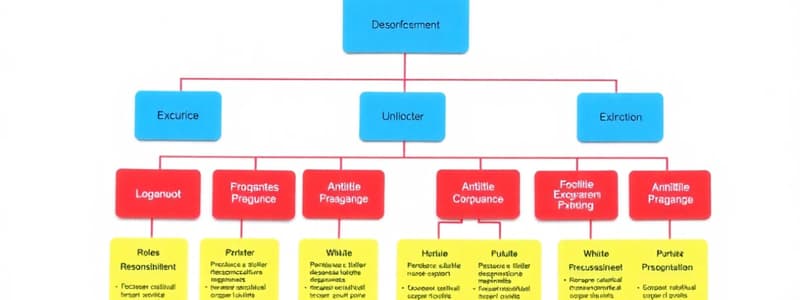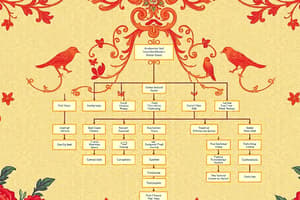Podcast
Questions and Answers
Why is executive-level support crucial for a program's success within an organization?
Why is executive-level support crucial for a program's success within an organization?
- It provides a strong signal to the rest of the organization about the program's importance. (correct)
- It guarantees the program will be immune to budget cuts.
- It automatically ensures the program's technical superiority.
- It eliminates the need for communication with other stakeholders.
What critical resource must be secured to properly develop a new organizational program?
What critical resource must be secured to properly develop a new organizational program?
- A significant initial investment of human resources, hardware, and software. (correct)
- A guarantee of minimal disruption to existing workflows.
- A dedicated marketing team.
- An endorsement from a celebrity.
How does organizational structure influence a company's operations?
How does organizational structure influence a company's operations?
- It has no impact on efficiency, flexibility or innovation.
- It is only relevant to companies with fewer than 50 employees.
- It determines how the business will operate and perform. (correct)
- It dictates employee's personal beliefs.
What distinguishes a 'role' from a 'responsibility' within a team?
What distinguishes a 'role' from a 'responsibility' within a team?
An established technology firm seeks to foster radical innovation. The CEO believes completely restructuring the existing organizational chart is the only way, despite potential short-term efficiency losses. Considering the text, which of the following organizational approaches balances long-term innovation with sustained operational efficiency?
An established technology firm seeks to foster radical innovation. The CEO believes completely restructuring the existing organizational chart is the only way, despite potential short-term efficiency losses. Considering the text, which of the following organizational approaches balances long-term innovation with sustained operational efficiency?
Flashcards
Executive Support
Executive Support
Executive-level buy-in is essential for a program's success. Without it, the rest of the organization is unlikely to support it.
Program Funding
Program Funding
Funding must be secured to properly support the program. Resources (human, hardware, software) require investment.
Organizational Structure
Organizational Structure
A company's structure dictates how it operates, allocates responsibility and performs.
Roles
Roles
Signup and view all the flashcards
Responsibilities
Responsibilities
Signup and view all the flashcards
Study Notes
- Translate business objectives into maintenance and reliability objectives
- Support the organization's business goals
Strategic Direction and Plan for Maintenance and Reliability (M&R) Operations
- M&R leaders create a vision, mission, and strategic plan.
- The plan guides the implementation of appropriate M&R systems.
- The strategic plan provides a clear purpose, defined goals, and organizational benefits.
- Goals are clear, measurable, and cascading (top-down).
- M&R leaders use industry benchmarks to establish goals, provide a measurement system, and identify gaps in processes.
- Operations, maintenance, and other disciplines should agree on goals and measures.
- Understanding everyone’s role in the strategic plan and responsibilities is vital.
- Regular review and discussion of progress are for team commitment, allowing periodic adjustments.
Concepts for Strategic Direction in M&R
- Comprehend the organization’s business goals.
- Understand current maintenance and reliability capabilities.
- Identify "the gap" between current capabilities and stated goals.
- Understand risk and culture.
- Establish a vision, mission, and strategic plan.
- Set clear and measurable goals.
- Align strategic plan and goals with overall business goals.
- Ensure stakeholders understand and support strategic plan and goals.
Strategic Planning Tools for M&R
- Balanced Scorecard
- Key Performance Indicators (KPI)
- SWOT Analysis (Strengths, Weaknesses, Opportunities, Threats)
- Risk Analysis
- OEE (Overall Equipment Effectiveness)
- Cost Concepts
- ROI (Return on Investment)
- NPV (Net Present Value)
- Benchmarking
Key Processes For Strategic Direction and Plan for M&R
- Create vision, mission, and strategic plan to support organizational business goals.
- Develop a business case for change.
- Develop cascading goals.
- Conduct benchmarking.
- Perform Reliability and Maintenance assessments.
- Identify leading and lagging KPIs.
- Conduct Gap assessment.
- Develop roles and responsibilities.
Definitions Central to Strategic Planning and M&R
- Mission
- Vision
- Strategic plan
Administering the Strategic Plan for M&R
- Develop a solid business case specifying financial benefits and operational risk mitigation.
- The business case should include an understanding of the changes required for the organization structure, personnel, roles, responsibilities, tools, training, and priorities Resources:
- Enhance support for resource requirements by ensuring management understands the value provided by the plan.
- M&R leaders should communicate the vision.
- Garner commitment to implementation and execution of the plan.
- Position champions to lead the effort and enlist support from key personnel.
Understanding Key Elements
The Vision
- A vision statement describes a future state in both short and long terms, typically two to ten years.
- Vision statements focus on tomorrow and what the venture would like to become.
- The language is often in the present tense.
The Mission
- A mission is a plan for achieving vision; it is a call to action.
- Business models are beneficial
- Mission statements help people share their vision.
The Strategic Plan
- Strategic Plan is a document communicates with the organization.
- To inform the team with the organization's goals
- Inform the actions needed to achieve those goals
- Inform other critical elements
The importance of Strategic Planning
- Helps an organization to set priorities
- Focus energy and resources
- Strengthen operations
- Ensure employees and other stakeholders work toward common goals.
Business Case and Stakeholder Benefits
- Define a business case as a well-reasoned argument.
- A business case is designed to convince an audience about the benefits of an investment and educate them about the effort's changes, costs, and risks.
- The purpose informs key stakeholders about the initiative and gains their support.
- A complete business case is a comprehensive package of information, analysis, and recommendations.
- Provides understandable language statement of the problem, significance, severity, complexity, key data, identification of customers, other stakeholders and how significantly are they affected by the problem.
- Clearly states assumptions, estimates, weaknesses, options, comparing features, costs, benefits, and stakeholder in each option.
- Concludes with a recommended action that presents strengths and weaknesses.
- Business cases are supported by various written and oral presentations.
- Key points that make the presentation organized, technical and detailed.
Champions in Strategic Plan Implementation
- Champions are a significant factor.
- An individual who identifies with a new development and uses all available resources against organizational resistance.
- Champions function as entrepreneurs within the organization.
- They lack official authority and often put their standing within the organization on the line.
- Champions are energetic and can invite and withstand disapproval.
- Strategic plans require ownership at both executive and staff levels.
- Identify champions at all levels.
- Involve all verticals of the organization, including marketing, strategy, planning, and business-development teams, to ensure buy-in.
- Opportunities across the organization and team alignment with goals are essential for plan execution.
Plan Understanding and Support
- Everyone must understand what the plan consists of, what are its goals, instruments, and the follow-up process.
Tools
Reporting Tools
- Reporting tools are software applications.
- The tools make data extracted in a query accessible to the user.
- A common reporting tool is a 'dashboard' that displays information in charts, graphs, etc.
- Access to the right information, at the right time is critical.
- Development tools, configuration tools, administration tools & viewing tools.
CMMS
-
Computerized Maintenance Management System (CMMS) software makes it easier for maintenance managers to track, manage and report their asset or equipment maintenance needs. Break the term down into individual components.
-
"Computerized" means the data is stored on a computer.
-
"Maintenance" meaning responding to work orders on time and performing routine inspections.
-
The software prioritizes tasks and ensures that everything is in place (inventory, labor)
-
This gives the technicians the freedom to focus less on paperwork and more on hands-on maintenance.
-
The core and essential role of a CMMS solution is "Management"
-
Maintenance management software is designed to give users immediate insight into the state of his or her maintenance needs with
-
It also contains comprehensive work-order schedules and accurate inventory forecasts.
-
Provides instant access to hundreds of invaluable reports.
-
Streamlines and makes maintenance management easier.
-
Systems: Different CMMS solutions offer diverse types of systems
-
The best CMMS systems allow users to accomplish existing maintenance practices more effectively.
-
Time-saving features that lead to cost reductions and further time savings
-
Enterprise Asset Management System (EAMS) is the optimal lifecycle management of the physical assets of an organization.
-
Subjects covered include the design, construction, commissioning, operations, maintenance and decommissioning or replacement of plant, equipment and facilities. To better understand what an EAMS is, we will break the term down into individual components.
-
"Enterprise" refers to the scope of the assets in the organization departments, locations, facilities; and potentially supporting business functions, including Finance & GL, Human Resources and Payroll.
-
An “Enterprise” often refers to more than one plant, often a group of plants, and often the term covers multiple operations within a single plant.
-
"Assets" may be fixed assets like buildings, plants, machineries or moving assets like vehicles, ships, moving equipment etc.
-
The lifecycle management of high-value physical assets.
-
This requires regressive planning and execution of the work.
-
Management: Includes Deploy maintenance resources effectively; Manage maintenance-related, work-order processes efficiently; Schedule maintenance based on asset condition rather than on arbitrary dates; Model scenarios to determine optimum preventive maintenance; Create customized reports to meet business-specific asset management needs.
EAMS helps companies to improve performance visibility using Maintenance Solutions. In order to:
- Analyze data for key trends/anomalies
- Forecast reliability issues
- Make forward-looking decisions to deliver improved bottom-line results
Key features:
- Work Orders
- Preventive Maintenance
- Asset Management
- Inventory Control
More
- Advanced Reporting and Analytics like customized reports which can forecast problems in time to prevent them. Financial Management:
- Purchase Requisitions (PR)
- Purchase Orders (PO)
- Approvals for Expenditures (AFE)
Scorecards
- A graphical representation of the progress
- Shown over time of an entity like a business unit or enterprise
- Works toward specified goals
- Performance scorecards are known to be widely used in industries.
KPIs (Key Performance Indicators) are also used as “dashboards” with the difference in the two is Scorecards must exhibit progress against a goal.
- Communicate plans to maintain
- Communication plans are to explain how to convey the right message from the right communicator.
- Plans should encompass events to inform:
- vision
- case for change
- goals
- programs
- metrics.
- Plans should encompass events to update:
- key personnel
- key audiences/stakeholders
- vision, case for change
- goals
- programs
- metrics
- Inform key contacts for answering questions. Provide input for ongoing feedback.
A communication plan needs the correct audiences, key messages, and timing.
Project Planning
Project management is the processes of initiating, planning, executing, controlling, and closing the work of a team to achieve specific goals.
- A project is temporary to produce a service, result, or unique product.
- Time-constrained and constrained by funding or deliverable(s).
- Results in value or change.
- Project management is a process that requires special management and technical skills.
- Project primary goals are to achieve all the project goals within the given constraints.
- Constraints being: scope, time, quality and scope.
- Optimize the allocation of necessary inputs and apply them to meet pre-defined objectives.
Milestones
- Tools used in project management to mark specific points on a project timeline are called milestones.
- Such as: end and start dates, need for review.
Plan implementation process that considers stakeholders
- Present the business to stakeholders like addressing the allies; gain stakeholders buy-in and formal change within.
- Communicate and gather executive support and staff level employees with assurance on funding for support.
- Structure the staffing like task allocation, coordination/supervision oriented with achieving goals.
- Determine the team roles, responsibilities and expectations by use of performance indicators to evaluate what is being performed.
- Determine training needs (8 ideas) that the organization requires to be trained on with plans to benchmark for success.
Implementation Plan Guidelines
Plan implementation with objectives that are clearly defined with assign tasks that have managers to get the objectives. Tasks need a timeframe: Time Allocation - Should be aggressive but reasonable to Competent-work and you use a Gantt chart to view tasks and the completion percentage of the objective. Resources include Human, Financial and Material to achieve goals. KPIs measure a company's performance in critical areas.
Key Factors for developing KPIs:
- Review mission, vision, and alignment of strategic plan
- Write out the process expectations for an organization
- Develop the input of Leading Key Performance Indicators(KPIs)
- Develop the output of Lagging Key Performance Indicators(KPIs)
- Develop Qualitative Performance Measures that measures attitudes and gauge amounts in numbers
- KPIs provide a multiple dimension that has quantitive measurements for business success
Balanced Scorecard:
- Financial (shareholders) measures the economic impact
- Customer means delivering quality that meet expectation
- Internal Business Processes for customer satisfaction (project management, and Six Sigma)
- Learning and Growth (staff morale, training, and knowledge share)
The Matrix for developing KPIs:
- Set a long-term target
- Determine leading and lagging goals
- Indicators linked together
- Break the indicator down quarterly/monthly.
- The duties and obligations to satisfactorily fulfill.
- In order to identify goals: the correct use without deviation of instruments, identify resources, determine actors to assure each situation/task performance.
Teamwork
- Training Material
- Communication
- Incentive
- Performance
- Leadership
- Revise the plan frequently with access and define these in a plan. Audits that provides assurances to stakeholders for all materials are free from the influence of others.
- A communication plan defines processes that transmit ideas, information in a way that it can be consumed by people.
- Implementation, evaluate, and perform actions.
- Incentive to move a team - can be through recognition of goal accomplishment and development of process and the project with value and contribute to organizational success.
- KPIs can be improved by training the factors of monitoring and evaluation with the correct dissemination. Performance
- Expectations or standard operating procedures, rules, guidelines should have the plan timeline and be in the KPI tracking.
Leadership Presentation
Should be short, tight and to the point of executives goals.
- Follow the 10% Rule - Summarize up front with key high level finding's to support discussions
- Rehearse and improve the communication for company leaders.
- Generate plans and revise for KPI and feedback actors
- Electronic data-collection systems will be helpful to use weekly with feedback and positive/negative
- Communicate exemplary to the achievements.
- All must have global achievements for success Organizational changes leadership that influence and sustain changes. People's progress during the processes to keep the change management in mind. There must be clarity across all stages of change.
Change must be shown at the top to be successful.
What to manage during change:
- What stakeholders are being affected
- How they will react
- How to assist in a change curve.
- What are the objectives
Studying That Suits You
Use AI to generate personalized quizzes and flashcards to suit your learning preferences.
Related Documents
Description
Explore the importance of executive support, resource allocation, and organizational structure. Differentiate between roles and responsibilities. Understand organizational structure influence on company's operations.




